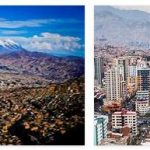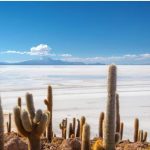Internal state of South America. It was part of the viceroyalty of Peru until 1776 with the name of Alto Peru or Audiencia de Charcas. Later incorporated largely into the Viceroyalty of La Plata, it became independent from Spain in 1825, taking the name of Bolívar, in honor of his liberator, Simón Bolívar, who later wanted it to be transformed into that of Bolivia. Politically borders N. and E. with Brazil (Territory of Acre and states of Amazonas and Matto Grosso), S. with Paraguay and Argentina, West with Chile and Peru. The border with Brazil (about 2500 km.) Is marked, for long stretches, by the course of important rivers, such as the Acre and the Abuna (a tributary of the Purús the first, the Madeira the second) to the north, the Madeira, the Mamoré, Guaporé and Paraguay to the east. The northern border was established with the Petropolis treaty of 1903 (see acre) and marked on the ground between 1907 and 1909; the eastern one was defined with the treaty of 1867 and tracing was carried out between 1871 and 1878. The border with Peru, about 890 km long. and partly marked by the course of the Rio Heath, a tributary of the Madre de Dios, it divides Lake Titicaca in two, the eastern shore of which is Bolivian, with the islets facing it and most of the Copacabana peninsula. In some areas (such as in the Apolobamba region), it was difficult to define it, so much so that in 1910 a war between the two states was close; it was then regulated between 1911 and 1913 with the intervention of an English commission. The border with Chile, defined in various stages (1866, 1874, 1904) is about 900 km long. Recently Bolivia intervened in the question between Peru and Chile for the territory of Tacna and Arica (v.), Trying, with the support of the United States, to regain at least part of the coastal territory it had lost following the unfortunate war with Chile of 1879-1883; but without a positive result, because the two contending states did not comply with the proposal of the United States and divided the territory in question (1929). For Bolivia 1996, please check pharmacylib.com.
The border with Argentina, about 770 km long, was delimited in 1889 and then in 1925, when Argentina recognized Bolivia as possessing Yacuiba with a small surrounding territory. The border with Paraguay is still uncertain. Bolivia claims the possession of all the so-called Chaco Boreal, that is, that territory which, like a wedge, stretches between the Pilcomayo and the Paraguay River. On the other hand, Paraguay disputes Bolivia’s possession not only of the Chaco Boreal, but also of a significant part of the Bolivian provinces of Tarija, Chuquisaca and Santa Cruz, up to N. of the 20th southern parallel. These are very depopulated regions, still little known, but which may soon have great economic value. The issue, repeatedly, has led to serious conflicts between the two states: even in late 1928 they came to arms. The most commonly accepted and marked border in the maps is the straight one which, starting from Pilcomayo downstream of Fortín Campero (22 ° 10 ′ S.), crosses the Chaco and reaches Paraguay at Forte Olimpo (21 ° 8 ′ S.: length 430 km.). The total development of Bolivia’s borders would be approximately 5500 km. Within this perimeter there is an area that Riccardi’s cartometric measurements bring up to 1,208,500 sq km. (including inland waters, i.e. the Bolivian part of Titicaca, 3936 sq km, and Lake Poopó, 3690 sq km). This figure is, as is well understood, considerably lower than the official one (1,332,808 sq km), which excludes inland waters, but includes all of the Chaco Boreal.
By surface, Bolivia ranks third among the South American states, after Brazil and Argentina; its area is 1 / 15 of that of South America. The population, estimated at 1929, would be about 3,500,000 residents (1 / 23 of the total of South America), with an average density of 2.6 residents per sq. km. By absolute population, Bolivia ranks 6th among the South American states. The territory of Bolivia is between 9 ° 40 ‘and 22 ° 10’ of S. latitude, and 57 ° 35 ‘and 69 ° 30’ of long. OR.





